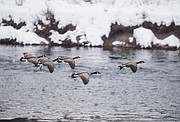Snowy December boosts mountain snowpack
Record-breaking rain through the fall in Northwest Montana provided a welcome boost to the region’s long-term water supplies, while a snowy December has pushed mountain snowpack close to normal levels throughout the Northern Rockies.
A snowy start to winter in Western Montana has padded mountain snowpack throughout the region, bringing the region’s totals closer to the norm after an unusually warm fall season.
Snow-water equivalent, used to measure the amount of frozen water locked up in the mountains as snow, had reached 95 percent of normal in the Flathead River basin on Tuesday, according to data from snow telemetry sites in the drainage. The Kootenai River basin’s snow gauges registered snowpack at 92 percent of normal.
Through December, Northwest Montana has typically received 35 to 40 percent of its seasonal snowpack, according to Lucas Zukiewicz, a water supply specialist with the Montana Snow Survey Program.
Since the current water year began Oct. 1, precipitation has been well above average — especially after record rainfall drenched the region during the month of October. While warm temperatures meant little of that precipitation fell as mountain snow, it still bodes well for next summer’s water supply, Zukiewicz said.
“An important consideration heading into the snow season is what does the soil look like before it gets covered with snow,” Zukiewicz said Tuesday. “We think about things in long-term cycles, too: how much of that water is going to move into the groundwater?”
High-elevation snowpack helps maintain a consistent supply of cold water as streamflows dwindle in the region’s dry summer months. But groundwater also provides a significant share of that total, and Zukiewicz noted that last fall’s above-average precipitation will help recharge aquifers that were depleted by the notably dry summers of 2015 and 2016.
The Flathead River basin’s high-elevation areas have received 131 percent of their normal precipitation this water year. The Kootenai River basin is at 139 percent.
Zukiewicz added that several telemetry sites in the Kootenai drainage set new precipitation records in October, which was the all-time rainiest month in several Northwest Montana locations.
“The more we can put in early, until we get to our summer season, the more efficient our runoff is and the more water we get in our rivers,” he said. “It was a great start to our water year, so far.”
Reporter Sam Wilson can be reached at 758-4407 or by email at swilson@dailyinterlake.com.




